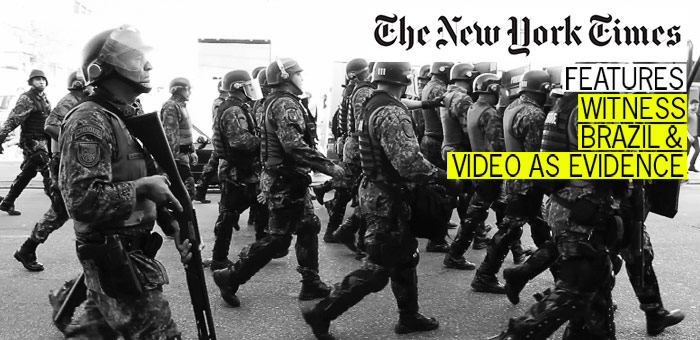Police Violence, Video as Evidence and Brazil
We are thrilled to announce that WITNESS’ work in Brazil and our groundbreaking video as evidence initiative are featured in a New York Times article about media activists operating in the country’s favelas.
Called “The Media Doesn’t Care What Happens Here,” the story follows WITNESS partners and allies as they document police violence in the country.
In particular, journalist Matthew Shaer introduces Raull, the co-founder of a media collective in Rio de Janeiro. Our Senior Program Manager Priscila Neri has worked with Raull – and many activists like him – in an effort to document police violence effectively so that their video can strengthen calls for justice.
It is no small task. Activists estimate that police violence in Brazil kills thousands each year and marginalized favela communities are the most affected.
Important though for these Brazilian activists is that the country’s media largely ignores the epidemic. Says Raull in the article:
“Four or five bodies show up, six bodies, maybe it makes the news. One body? Never. The media doesn’t care what happens here. They’d rather not think about it.”
Their solution has been to film and document what traditional media has not covered: ongoing and systemic police violence in the favelas.
WITNESS’ collaboration with media groups like Raull’s has included efforts to turn footage taken on the frontlines of human rights abuse into justice, a central component of our video as evidence initiative.
Via The New York Times:
[WITNESS] believed that the footage shot by local residents in the world’s most dangerous places could be used not just to draw attention to acts of violence but also to put the responsible parties in prison. It was a novel vision for how criminal justice could evolve in the era of the smartphone, and the young members of [the media activist group] Papo Reto seemed like the perfect partners.
It is not only in Brazil that activists and lawyers are searching for ways to turn footage taken on the frontlines of human rights abuse into justice. With cameras in the hands of millions of people worldwide, more light is shining on abuses than ever before.
However, while citizen video often provides helpful clues about what took place and who might be responsible, the footage rarely meets the requirements for evidence in a court of law. As Kelly Matheson, our Senior Attorney and Video as Evidence Program Manager explains:
Evidentiary work requires a more detached eye. “It’s instinctual to shoot that puddle of blood or the body lying on the ground,” Matheson [tells The Times]. “It’s not instinctual to turn around and get a badge number or the location of a communications tower. If you’re strictly a media activist, you’re not going to show the world a communications tower. It’s not going to make the news. It’s not going to mobilize anyone. But from a legal sense, you need those details.”
You can read the article here — and please share with your networks so everyone, everywhere begins to understand how to use video for justice.
Also, congratulations to the New York Times Magazine for the redesign of both their print and digital editions. We’re so happy to be included in their launch issue.
More Brazil, More Video as Evidence
Learn about tools and guidance we’re developing to help activists ensure that their footage can serve as evidence in criminal and civil justice processes.
Read WITNESS Executive Director Yvette Alberdingk Thijm’s thoughts in the Huffington Post on video as evidence
Read what WITNESS Co-founder Peter Gabriel has to say about the potential power of video evidence.
Learn more about WITNESS’ work in Brazil.

